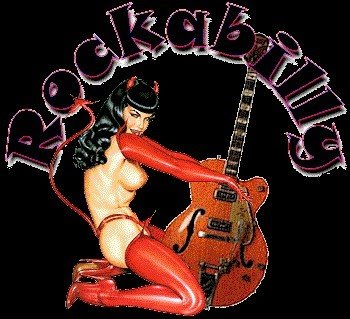
Rockabilly is one of the earliest styles of rock and roll music, and emerged in the early 1950s.
The term rockabilly is a portmanteau of rock (from rock 'n' roll) and hillbilly, the latter a reference to the country music (often called hillbilly music in the 1940s and 1950s) that contributed strongly to the style's development. Other important influences on rockabilly include western swing, boogie woogie, and rhythm and blues. Although there are notable exceptions, its origins lie primarily in the southern United States.
The influence and popularity of the style waned in the 1960s, but during the late 1970s and early 1980s, rockabilly enjoyed a major revival of popularity that has endured to the present, often within a rockabilly subculture
There was a close relationship between the blues and country music from the very earliest country recordings in the 1920s. The first nationwide "country" hit was "Wreck of the Old '97",[1][2] backed with "Lonesome Road Blues", which also became very popular.[3] Jimmie Rodgers, the "first true country star", was known as the “Blue Yodeler,” and most of his songs used blues-based chord progressions, although with very different instrumentation and sound than the recordings of his black contemporaries like Blind Lemon Jefferson and Bessie Smith.[4]
During the 1930s and 1940s, two new sounds emerged. Bob Wills and his Texas Playboys were the leading proponents of Western Swing, which combined country singing and steel guitar with big band jazz influences and horn sections; Wills' music found massive popularity. Recordings of Wills' from the mid 40s to the early 50s include "two beat jazz" rhythms, "jazz choruses", and guitar work that preceded early rockabilly recordings. Wills is quoted as saying "Rock and Roll? Why, man, that's the same kind of music we've been playin' since 1928!...But it's just basic rhythm and has gone by a lot of different names in my time. It's the same, whether you just follow a drum beat like in Africa or surround it with a lot of instruments. The rhythm's what's important.
After blues artists like Meade Lux Lewis and Pete Johnson launched a nationwide boogie craze starting in 1938, country artists like Moon Mullican, the Delmore Brothers, Tennessee Ernie Ford, Speedy West, Jimmy Bryant, and the Maddox Brothers and Rose began recording what was known as “Hillbilly Boogie,” which consisted of "hillbilly" vocals and instrumentation with a boogie bass line.
The Maddox Brothers and Rose were at "the leading edge of rockabilly with the slapped bass that Fred Maddox had developed". Maddox said, "You've got to have somethin' they can tap their foot, or dance to, or to make 'em feel it." After WWII the band shifted into higher gear leaning more toward a whimsical honky-tonk feel, with a heavy, manic bottom end - the slap bass of Fred Maddox". "They played hillbilly music but it sounded real hot. They played real loud for that time, too..." The Maddoxes were also known for their lively "antics and stuff." "We always put on a show... I mean it just wasn't us up there pickin' and singing. There was something going on all the time. the demonstrative Maddoxes, helped release white bodies from traditional motions of decorum... more and more younger white artists began to behave on stage like the lively Maddoxes. Others believe that they were not only at the leading edge, but were one of the first, if not the first, “Rockabilly” group.
Indie Kita
From Wikipedia
No comments:
Post a Comment